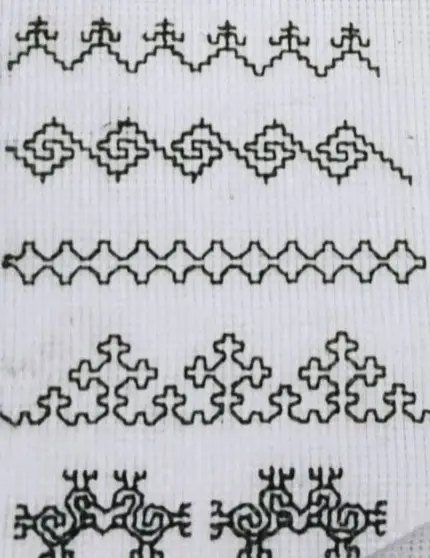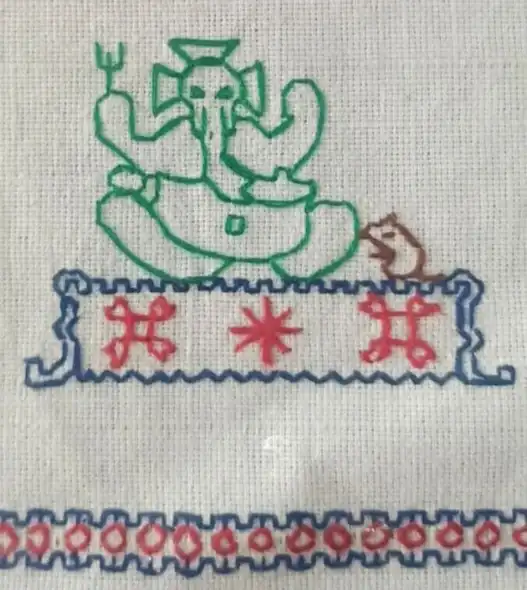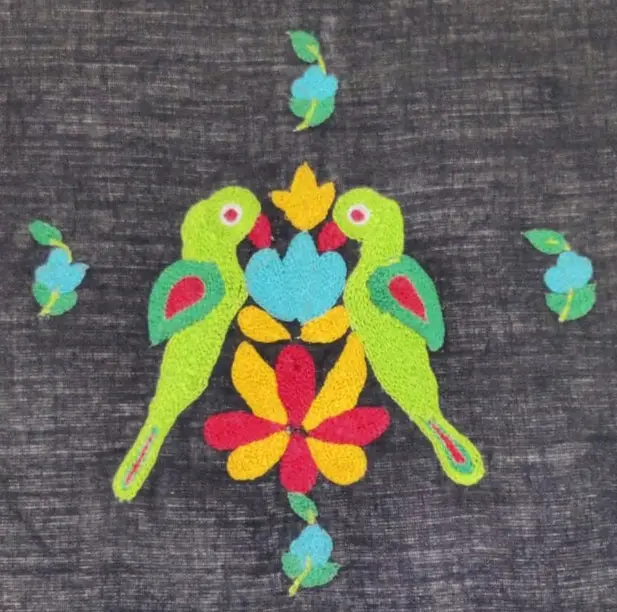Hand Embroideries / Needlework
- omemy tutorials
- Jan 31, 2024
- 8 min read
Updated: Oct 15, 2025

Maya has just started her school vacation; it’s different this year though! All these years, she was used to packing her bags and proceeding to an expensive holiday with her parents. This year Maya’s mom Grace decided to spend time with their grandma, Daksha at her ancestral home. While Maya loved the grand welcome and the affection displayed by her grandma, she was particularly missing her favourite TV shows, mobile phone, etc. It’s not that there was no connectivity at her grandma’s place, there were super strict restrictions about how much time she could spend on digital screens, ‘My house, My rules’, said the grand old lady!
Maya just didn’t know how to spend her time without digital screens and she was bored to the hilt! After her futile episodes of tantrums & upset, Maya was forced to take a look around the house and find something to spend her time. The dominant boredom and extra time-in-hand, made her aware of some interesting things in her surroundings, that she had never noticed before. Her grandmother’s place was nothing short of a house of wonders with almost everything in the decor unique and hand-crafted! Hand-embroidered pillows, landscape paintings on the wall, and more. This was so different from the bought decor prevalent in her circle, you could find something similar in every other house she had been to!
She noticed how her grandmother used to spend lazy afternoons embroidering lovely motifs on the corners of new pillow covers! Not finding anything else to do, she decided to keep her tantrums aside, and sat observing her granny in the hand-embroidery sessions.
‘Would you like to try this’, was the unexpected response from the senior lady!
‘What me? Oh,we youngsters do big things in academics, sports or something digital…you know….real skills for 21st centuryl!’
‘No harm trying it once, now that you are trapped in my century for few days!’
…And voila!....always prepared for everything granny, opened her ornate desk and appeared a lovely gift bag. Contents of the embroidery bag…
Materials required for Hand Embroidery
Embroidery threads
Embroidery scissors
Round embroidery frame
Embroidery needles
Fabric pencils
Tracing papers
Thread clippers
Thimble
Fabric
…and what should I start with….exclaimed Maya!
‘You can help me with something I have started’.
Daksha, gave her a table cover with some printed motifs. ‘Just run the needle up and down the line, but make sure that the action is equidistant. But before you start, let’s learn to lock the thread’.
How to lock the thread before starting embroidery...
‘Oh, I know that bit….I will roll the thread end between my fingers a couple of times and a knot will be formed. This will rest at the back of the fabric and lock the thread…correct?’ beamed Daksha.
‘Well…that’s a bit amateurish, let’s learn how professionals start their embroideries!’ Daksha made Maya make a few overlapping back stitches at the same spot on the fabric leaving a small tail of thread at the back. The thread itself locked between the yarns of the fabric, without leaving an ugly lump at the back. ‘Oh, that was some technique’, thought Maya.
Next, she started covering the printed lines on the pattern, running the needle up & down the fabric. ‘What is this stitch called Grandma?’, ‘Running Stitch’ was the prompt response!
As Maya’s needle progressed through the fabric, her boredom and prejudice to the craft started evaporating. As, she embroidered curved lines, one after the other, it felt as if she was going through a journey. A journey so encompassing, that for some time, it made her forget about all the negative thoughts and stressful episodes that her notorious, teenage mind otherwise played again and again.
Surprisingly, Maya found herself enjoying the craft! Every time she finished a section, there was a sense of proud, satiety, and something else that she couldn’t explain. She completed the motif in next few days and couldn’t keep herself from looking at the piece of art again and again. The pride in her eyes of being able to create something beautiful & tangible, that will now be proof of her dexterity, focus & aesthetic sense forever was amazing. Granny happily gifted the table cover to Maya and asked her to keep it. She would proudly show it to her friends when she went back home after vacations.
Now, that beautiful piece of art in running stitch was over, she wanted to learn more complex stitches. While scanning her granny’s study, Maya came across a lovely poster. This poster had a table with names, sub-styles & cultural information about a large number of hand embroidery stitches.
‘Are there actually so many!’ exclaimed Maya.
‘No, there could be many more, these are just the basic ones that every embroidery enthusiast, should know about. Embroidery as an art has been developed and perfected in every culture as per their own life experiences, skills and availability of resources. It can take a lifetime to gather all the amazing stuff that has been done by experts around the world in hand embroideries’, explained Daksha.
Common Embroidery Stitches
Stitch | Variations | Style | Reversible | Regional Styles |
Running |  | Line | Yes | Kantha, Spanish Black Work |
Interlacement | Line/Block | No | Kantha | |
Double Running | Line | Yes | Kasuti, Spanish Black-work | |
Back |  | Line | Yes | Kasuti, Black work |
Chevron Stitch | Block | No | European Embroideries | |
Turkey work | Surface | No | European Embroideries | |
Stem |  | Line | Yes | Asian Embroideries, Spanish Black work |
Split Stitch | LIne | No | European Embroideries | |
Chain |  | Line | No | Kutch, Mochi, Ari, Kashida, European Embroideries |
Lazy Daisy | Block | No | European Embroideries | |
Threaded Chain | Line | No | European Embroideries | |
Zig-zag chain | Line | No | European Embroideries | |
Twisted chain | Line | No | European Embroideries | |
Squared chain | Line | No | European Embroideries | |
Feathered Chain | Line | No | European Embroideries | |
Heavy chain | Line | No | European Embroideries | |
Feather Stitch |  | Line | No | Universal |
Buttonhole/Blanket |  | Edge/Shape | Yes | |
Long & short blanket | Edge/Shape | No | European Embroideries | |
Closed blanket | Edge/Shape | No | European Embroideries | |
Double blanket | Edge/Shape | No | European Embroideries | |
Knotted blanket | Edge/Shape | No | European Embroideries | |
Overcasting |  | Edge/shape | Yes | Generic |
Cross |  | Block | No | Canvas, Counted thread work |
Double Cross | Block | Can be | Spanish Block Work | |
Sindhi Taropa |  | Block | No | Sindhi Embroidery |
Couching |  | Surface | No | European Embroideries |
Circular couching | Block | No | European Embroideries | |
Satin |  | Shape | No | |
Basic | Block/Shape | Yes | Kashida & Chamba Rumal | |
Surface | Block/Shape | No | Phulkari | |
Long & short | Block/Shape | No | Kashida & Chamba Rumal | |
Padded Satin stitch | Block/Shape | No | European Embroideries | |
Herringbone |  | Shape | No | Gujarat Kutch Embroidery, Bengal Kantha Embroidery |
Double herringbone | Shape | No | European Embroideries | |
French knot/Bullion |  | Knots | No | European Embroideries |
Smocking |  | Surface | No | European Embroideries/ Indore work |
Pattern darning | ||||
Pulled Work/Open work | Block | Yes | Luckhnow Chikankari / European Embroideries | |
Cut work/Open work | Shape | Yes | European Embroideries | |
Drawn thread work/Open work | Shape | Yes | European Embroideries | |
Basic Weaving stitch | Surface | No | European Embroideries | |
Woven Web | Surface | No | European Embroideries | |
Spiders Web | Surface | No | European Embroideries | |
Stone / Metal Embroideries |  | Surface | No | Asian & Middle Eastern Embroideries |
Day-after-day Maya spent hours with her grandmom and her equally grand poster,

picking up one stitch after the other and developing some motifs on a sampler, so that she could carry it home for reference whenever she wanted to practice hand-embroideries. It was through conversations in these leisure hours that the amateur embroiderer realised the importance of fabric , thread and needle selection for making hand embroideries:
How to select right kind of fabric, Needles and Threads for Hand Embroidery...
She realised that although embroideries can be done on almost every kind of fabric, canvas and matty are the first choice for amateurs as they can literally count the number of threads, and holes to be able to produce a uniform embroidery. Similarly when it comes to thread selection, always begin with twisted cotton threads and as one becomes comfortable with the art, twisted and untwisted silk threads could be used as well. The needles for embroidery would come in different thicknesses and sizes. Beginners could use tapestry needles (thick and blunt points can be used in fabrics with already defined holes). However, more confident embroiderers, working on thinner fabrics would work with sharp-tipped, thinner needles that would slide between the yarns but not make a damaging hole in the fabrics. So, the finer the fabric, the finer the needle is the thumb rule.
However, Granny’s training didn’t just limit itself to embroidery stitches. In the course of their conversations, she would explain to Maya the art and science behind color combinations, how colours and stitches could be used to visually communicate without the help of words etc.
Picture Credits: Manjul Malhotra
Picture Credits: Nitika Garg
Picture Credits: Prachi Mehrotra
However, the most tedious part of these sessions was that before every session, granny would make Maya read all safety precautions to be taken while working on hand embroideries. ‘It is important to keep yourself, people sitting around you safe and your work environment tidy; irresponsible behavior with pins and needles can lead to fatal accidents.’ So she was made to repeat everyday:
Safety Precautions for Hand Embroidery
Always sit with a pin-cushion at an approachable distance. All the pins and needles not being used at that point of time should be safely secured in the pin cushion.
Whenever you want to take a short/long break from embroidery, do not leave the needle hanging from the fabric. Secure it safely double dipped in the fabric, the way you would do for a running stitch.
You can use thimble to protect your thumb and fingers from pin pricks.
Never use old, rusted needles and pins. These can cause serious infections with a small prick.
Discard rusty or broken pins and needles safely wrapped in a paper before throwing it away in the bin. This is for the safety of people who might be engaged in sorting or disposing the garbage.
Always keep a strip of small bandges handy in your embroidery kit to deal with pin pricks.
While embroidering, never pull the needle in the direction of your eyes/face or towards someone else sitting around you. This will help avoid accidental pin pricks to your own body and people sitting around you.
The embroidery thread in the needle should not be so long that you have to pull your hand away from the shoulder to pull the thread out of the fabric. Too long a thread increases the possibility that you might inadvertently hurt yourself or the person sitting next to you.
Never practice embroidery in crowded spaces where you do not have enough space to move your hands safely.
Do not practice embroidery in moving vehicles.
Last, but not the least, pack the contents of the embroidery kit immediately after the work is completed for the day. Do not keep the contents open and scattered even if you have the luxury of a secluded work area.
Oh, that's a long list, one that she has to go through religiously everyday, before starting on her work.
Embroidery Crafts are good for Mental Health and Well-being!
The vacations ended and Maya said goodbye to her granny & her house of wonders with a proud bag, full of her own hand-embroidered wonders. These pieces of art would forever be a testimony and happy reminder of her capabilities, the fruitful time spent with her granny, and the lifelong learning she got in the process.
On her flight back home, Maya kept thinking about the strong, deep and calm feeling of achievement that she felt after completing every hand-embroidery motif. The experience of constructing art pieces was so different than her experience on social media, computer games, and more where every achievement brought more stress and aggression, as if a package deal! While she had always looked to her screens for entertainment and to destress, she realized she had almost always exited the screen (tv, mobile, computer), more agitated than before. The feeling of happiness and self-satisfaction she got after pouring her heart out on the fabric and making individual decisions about design, colour combinations and stitches to be used; was unparalleled. Something that could not be described in words. Every craft she developed, left her so much calmer, proud, and observant towards small details she had missed out in her life so far.
This is the kind of stuff they say about therapies right?
-WebP.webp)


































